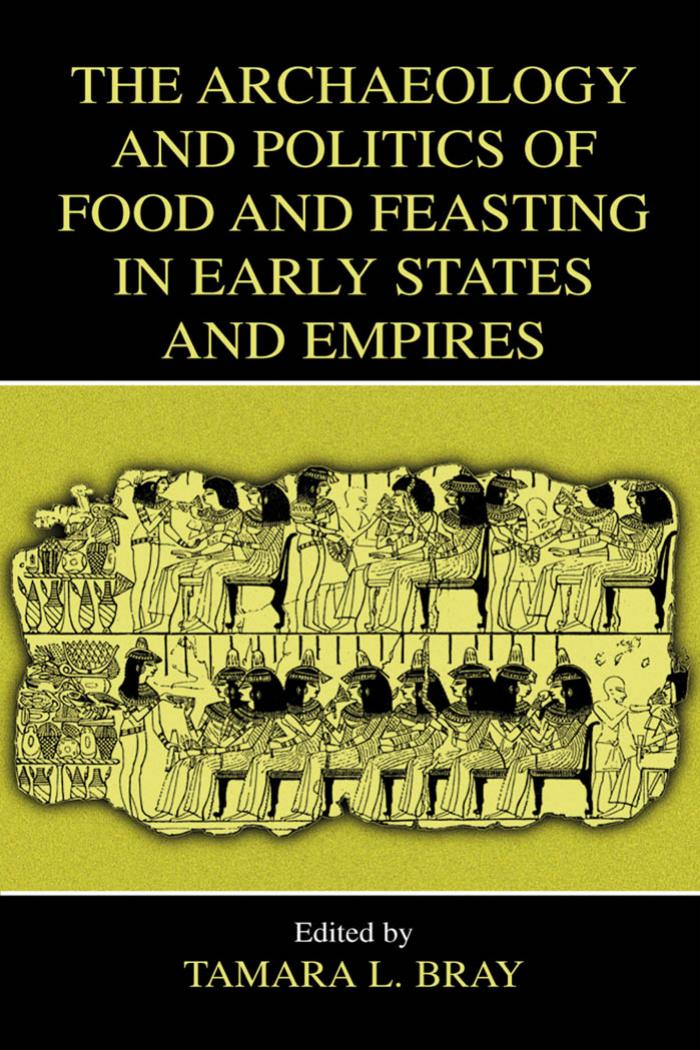The Archaeology and Politics of Food and Feasting in Early States and Empires by Tamara L. Bray

Author:Tamara L. Bray
Language: eng
Format: epub, pdf
Publisher: Springer-Verlag Berlin Heidelberg 2004
Published: 2015-02-13T16:00:00+00:00
Since Morris’s work at Huánuco, other archaeological studies have also demonstrated the use of large-scale public contexts for Inca ceremonial feasting. In the Mantaro Valley, for instance, concentrations of large storage vessel sherds recovered near the ceremonial core of Hatún Xauxa suggest feasting ceremonies in public spaces of Inca provincial capitals (Costin and Earle 1989:710; D’Altroy 1981:83, 1992:174). Generally, then, our conception of Andean feasting is colored by the imperial model of Inca feasts that were provisioned by institutional brewers, took place in public contexts, and were closely associated with an extractive imperial political economy (see also Cook and Glowacki, this volume).
Nonetheless, the significance of chicha feasting to Inca society went beyond public political display. It should be stressed that the effects of a political economy withthis muchemphasis onchicha drink and feasting were not limitedtoanisolated public ceremonial sphere. With both a ceremonial and a financial reliance on maize as a medium for supporting followers, the Inca introduced the capacity for maize storageona massive scale by building extensive storehouses at strategically located provincial centers. In regions that had had no central governance before Inca control, the new state-local relationship under the pax incaica and the demands of Inca political economy also brought major shifts in settlement to maize-producing lands from fortified highland sites (D’Altroy 1992:193, 214; Hastorf 1993). People brought into the Inca political economy had many ways to consume maize, and work-party chicha drinking was only one of them. Whole cobs or shelled maize may have been a staple for the Inca armies because of its ability to be stored in bulk (D’Altroy 1992:174, 217) and alternate modes of preparation are likely. Provincial diet was clearly affected by the Inca conquest, and Hastorf found the ubiquity of maize to increase in Inca-contemporary domestic botanical remains. Carbon isotope analysisofvessel residues and human skeletal remains also bear out a decided shift to maize consumption in Sausa society under Inca control (Hastorf 1991, 1993:177). As Bray (this volume) suggests, the increasing importance of chicha and other maize-based recipesinInca-contemporary cuisineis also reflected in the adoption of Inca culinary equipment, both in contexts of ceremonial feasting and daily life.
The Inca case reminds us that high profile public patronage feasts may be only the tip of the iceberg when we consider the society-wide transformative effect of feasting and imbibing. Despite the conspicuous public display of the great political feasts of Inca governors, it seems likely that the chicha drinking ceremony was far more pervasive, and that microcosms of similar feasting behaviors were frequently enacted at the smaller scales of community, and even household contexts. In what follows, I will suggest that the state level feasts of the Inca were the culmination of a history of increasing political value attached to maize and chicha in Andean societies that began with the expansion of Tiwanaku civilization into optimal maize producing regions.2
Download
The Archaeology and Politics of Food and Feasting in Early States and Empires by Tamara L. Bray.pdf
This site does not store any files on its server. We only index and link to content provided by other sites. Please contact the content providers to delete copyright contents if any and email us, we'll remove relevant links or contents immediately.
| Arms Control | Diplomacy |
| Security | Trades & Tariffs |
| Treaties | African |
| Asian | Australian & Oceanian |
| Canadian | Caribbean & Latin American |
| European | Middle Eastern |
| Russian & Former Soviet Union |
The Secret History by Donna Tartt(16623)
The Social Justice Warrior Handbook by Lisa De Pasquale(11489)
Thirteen Reasons Why by Jay Asher(7788)
This Is How You Lose Her by Junot Diaz(5772)
Weapons of Math Destruction by Cathy O'Neil(5037)
Zero to One by Peter Thiel(4824)
The Myth of the Strong Leader by Archie Brown(4789)
Promise Me, Dad by Joe Biden(4447)
Beartown by Fredrik Backman(4418)
Stone's Rules by Roger Stone(4415)
How Democracies Die by Steven Levitsky & Daniel Ziblatt(4398)
The Fire Next Time by James Baldwin(4342)
100 Deadly Skills by Clint Emerson(4077)
A Higher Loyalty: Truth, Lies, and Leadership by James Comey(4032)
Rise and Kill First by Ronen Bergman(4012)
The David Icke Guide to the Global Conspiracy (and how to end it) by David Icke(3881)
The Farm by Tom Rob Smith(3872)
Secrecy World by Jake Bernstein(3782)
The Doomsday Machine by Daniel Ellsberg(3731)
